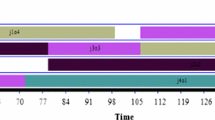Abstract
An assembly consists of two or more mating parts. The quality of any assembly depends on quality of its mating parts. The mating parts may be manufactured using different machines and processes with different standard deviations. Therefore, the dimensional distributions of the mating parts are not similar. This results in clearance between the mating parts. All precision assemblies demand for a closer clearance variation. A significant amount of research has already been done to minimize clearance variation using selective assembly. Surplus part is one of the important issues, which reduces the implementation of selective assembly in real situation. Surplus parts are inevitable while the assembly is made from components with undesired dimensional distributions. Batch selective assembly is introduced in this paper to reduce surplus parts to zero and it is achieved by using nondominated sorting genetic algorithm-II. For demonstrating the proposed algorithm, a complex assembly which consists of piston, piston ring and cylinder is considered as an example problem. The proposed algorithm is tested with a set of experimental problem datasets and is found outperforming the other existing methods found in the literature, in producing solutions with minimum clearance variations with zero surplus parts.
Similar content being viewed by others
References
Fang XD, Zhang Y (1995) A new algorithm for minimizing the surplus parts in selective assembly. Comput Ind Eng 28:341–350
Chen MS (1996) Optimizing tolerance allocation for mechanical components correlated by selective assembly. Int J Adv Manuf Technol 12:349–355
Chan KC, Linn RJ (1998) A grouping method for selective assembly of parts of dissimilar distributions. Qual Eng 11(2):221–234
Kannan SM, Jayabalan V (2001) A new grouping method for minimizing the surplus parts in selective assembly. Qual Eng 14(1):67–75
Kern DC (2003) Forecasting manufacturing variation using historical process capability data: application for random assembly and serial processing. Dissertation, Massachusetts Institute of Technology, pp 137–188
Mease D, Sudjianto A, Nair VN (2004) Selective assembly in manufacturing: statistical issues and optimal binning strategies. Technometrics 46(2):165–175
Kannan SM, Asha A, Jayabalan V (2005) A new method in selective assembly to minimize clearance variation for a radial assembly using genetic algorithm. Qual Eng 17:595–607
Fujino Y (1987) Matching problem when lot size is large. Rep Stat Appl Res 34:1–10
Shan HS, Satyawadi A (1989) Computer-aided component selection for precision assembling. 10th international conference on production research. University of Nottingham, UK, pp 734–739
Coullard CR, Gamble AB, Jones PC (1998) Matching problems in selective assembly operations. Ann Oper Res 76:95–107
Akachai Jantayavichit (2000) Efficient algorithms for tolerance improvement through selective assembly. Ph.D. thesis, University of Wisconsin, Madison, pp 128–160
Liu Z, Wong YS, Lee KS (2009) A manufacturing-oriented approach for multi-platforming product family design with modified genetic algorithm. J Intell Manuf. doi:10.1007/s10845-009-0365-8
Deb K (2003) Multi objective optimization using evolutionary algorithms. Wiley, England
Asha A, Kannan SM, Jayabalan V (2008) Optimization of clearance variation in selective assembly for components with multiple characteristics. Int J Adv Manuf Technol 38:1026–1044
Deb K, Pratap A, Agarwal S, Meyarivan T (2002) A fast and elitist multiobjective genetic algorithm: NSGA-II. IEEE Trans Evol Comput 6(2):182–197
Lind DA, Marchal WG, Wathen SA (2005) Statistical techniques in business and economics, 12th edn. McGraw-Hill Irwin, New York
Osma A (2009) A statistical approach to comparing wheel hub forging processes. Proc Int Mech Eng Part D J Automobile Eng 223:1559–76
Hwang CL, Yoon K (1981) Multiple attribute decision making methods and applications. Springer, Berlin
Author information
Authors and Affiliations
Corresponding author
Rights and permissions
About this article
Cite this article
Victor Raj, M., Saravana Sankar, S. & Ponnambalam, S.G. Minimizing clearance variations and surplus parts in multiple characteristic radial assembly through batch selective assembly. Int J Adv Manuf Technol 57, 1199–1222 (2011). https://doi.org/10.1007/s00170-011-3367-6
Received:
Accepted:
Published:
Issue Date:
DOI: https://doi.org/10.1007/s00170-011-3367-6




